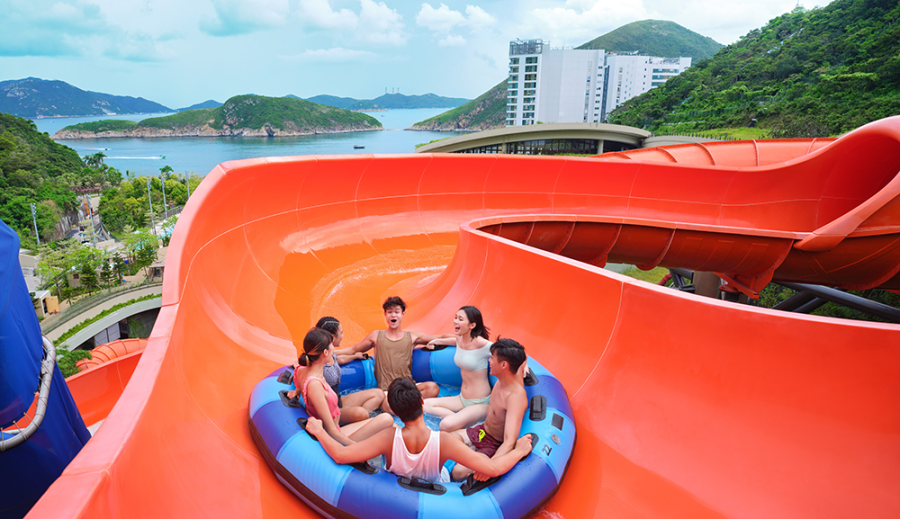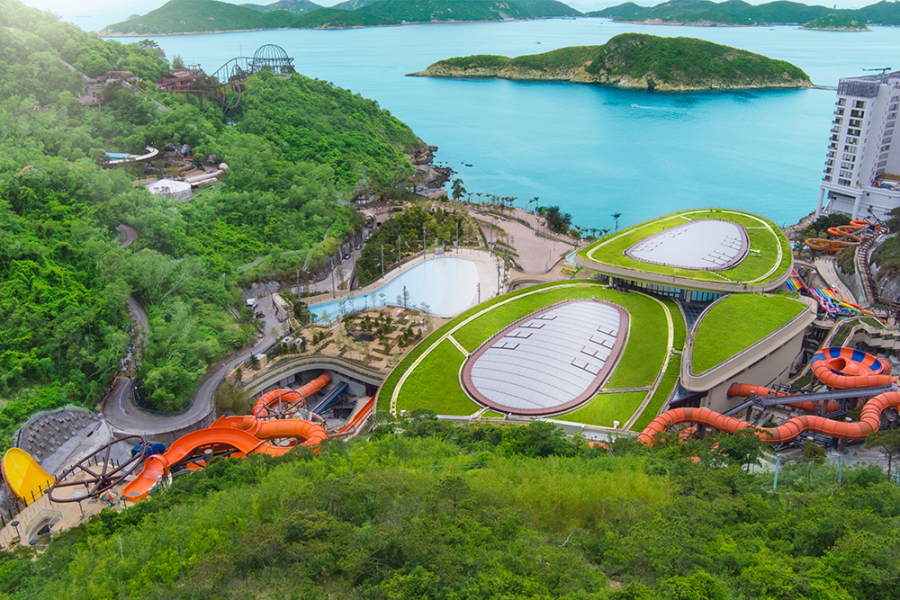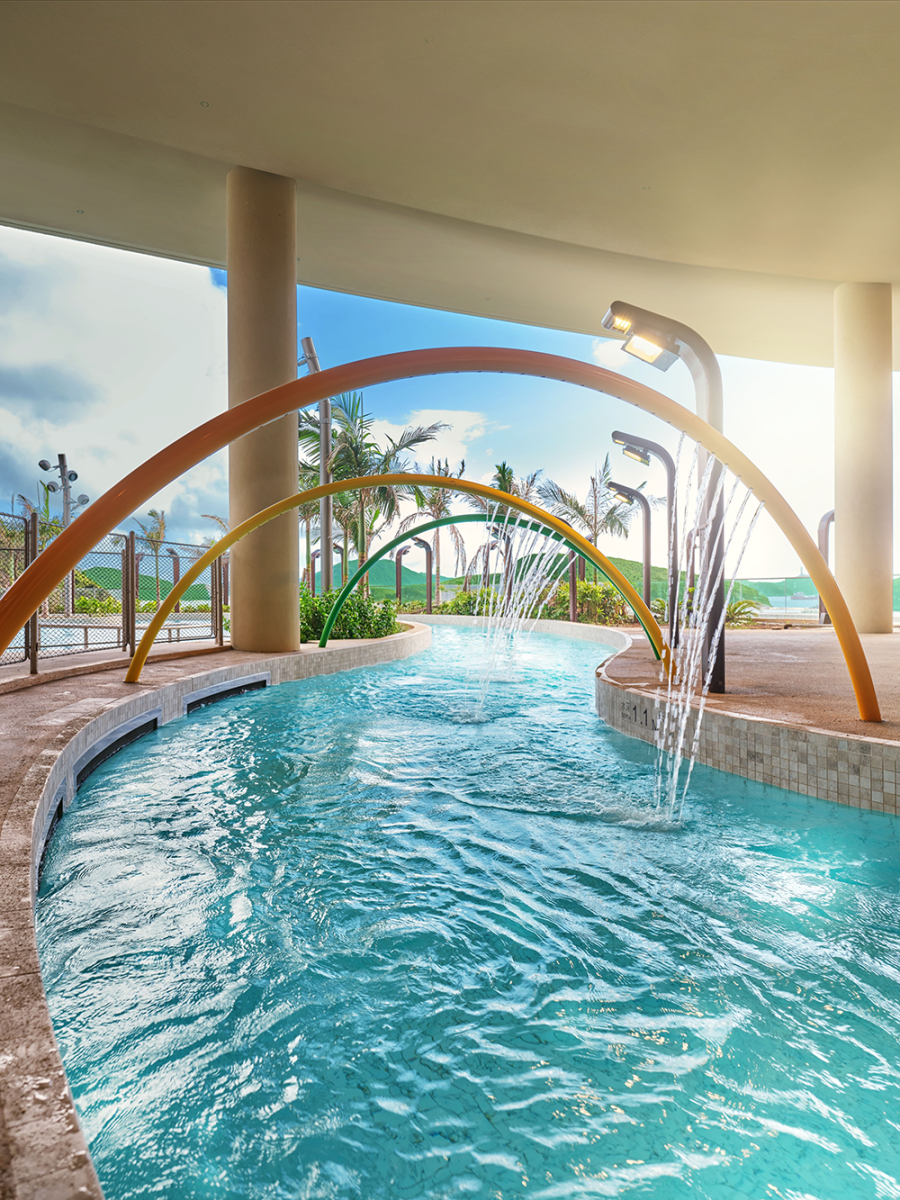Water World Makes a Splash

Viewed from the air, Water World Ocean Park Hong Kong is an unrivaled, amazing feat of design and construction, anchored onto the slope of a mountain along the shore of the South China Sea. A decade in the making, this all-weather, year-round water park is built vertically over 700,000 square feet of land and features 27 indoor and outdoor attractions spread across a series of terraced platforms and wave pools. The final price tag was about HK$4 billion.
The first things that capture your eye, as you look down from Ocean Park Hong Kong’s summit, are Water World’s rooftops: two massive, elongated discs that jut out toward the sea. Each has an outer ring of green vegetation circling it like a racetrack, with massive ETFE (ethylene tetrafluoroethylene) skylights occupying the infield. Closer to the mountain, bright orange and rainbow-colored slides twist and swirl, while farther out, pools, cabanas, and greenery appear suspended in the air.
“It was really the design that drew me to the project. As soon as I saw the renderings, I was amazed and sold. I’ve never seen a park that’s as beautiful to look at as it is to look out from,” says Water World Executive Director Bryan Fish, who adds that his favorite haunt at Water World is the resort-styled area with cabanas interspersed amid trees and stellar views of the Aberdeen Channel’s islets and emerald green waters.
There are no straight lines at Water World, only curves, arcs, and raking columns.
“Ocean Park’s philosophy was to create a park that looked as if it had always been there, existing in harmony with the rest of the valley,” recalls Thomas Ho, the recently retired chief executive of Gammon Construction, which built the park.
“We wanted to blur the interface between outside and inside,” adds Walter Kerr, a consultant and former Ocean Park executive director, who was responsible for delivering the water park from concept through detailed design and construction.
The steep gradient of the setting presented construction challenges but also made it possible to build gigantic water slides without having to con-struct extensive supporting structures.
“This was not an easy concept to do,” says Allan Zeman, former Ocean Park chairman. “The budget doubled, but at the end of the day, we wound up with something that is really spectacular.”

Water World No. 2
In 1984, seven years after Ocean Park’s debut, the company opened a popular seasonal attraction, right by the front gate, called Water World. Adults and kids alike loved to cool off on a hot summer day in the lazy river and race down the iconic five-lane rainbow slides. Most years, Water World would open in May and close in mid-September when kids went back to school. But in 1999, as company officials were looking for a way to stem the financial losses that had begun a year earlier, Ocean Park closed Water World for good. It was too expensive to operate and maintain the seasonal park.
Hong Kongers never forgot about Water World, though, and often reminisced about the thrill of cooling off on its slides during the summertime. So, when Zeman and then-CEO Tom Mehrmann surveyed the backside of the park, home to another shuttered attraction—a crafts village called the Middle Kingdom—they immediately saw the opportunity to revive Water World.
“It was a part of people’s history, like Ocean Park itself,” Zeman recounts. “I thought to myself, ‘It’s always been here; we just want to enhance it and make it the best in the world.’”
This idea that Water World was always a part of Ocean Park, both in its history, as well within the mountainside itself, waiting to emerge, became a key element of the water park’s design, philosophy, and lore.

(Photo Credit: Water World Ocean Park Hong Kong)
An Indoor Park Like No Other
While the most iconic images of Water World are taken from above, for most visitors, the great reveal occurs after passing through the ticketing gantries on the ground level and entering what Kerr refers to as the “vast, spacious caverns of fun.”
At the front of the hall, about 10 meters overhead, riders in tubes float by in a lazy river. Arched acrylic panels provide new entrants with a clear view of the rivergoers, who pass through arctic, rainforest, and other thematic zones on their 12-minute journey. A 14-meter waterfall, one of six such cascades in the park, descends past the river to the lobby floor.
Out of sight, but certainly not out of earshot, exuberant parkgoers plunge down three varieties of WhiteWater AquaLaunch speed slides, as well as the “Skyhigh Falls” Boomerango. Their screams and laughter can be heard as they splash into run-out lanes and a pool one level up, to the right.
Water World has five platforms for ride dispatch. Spiral ramps and an elevator provide the means for guests to ascend; the final walk to any ride is up steps, fashioned into the mountain slopes, with each route divided into two paths to allow for fast-pass access. The way the park is designed, visitors can never see everything at once. This feature adds to the mystique but can make it difficult for new visitors to find the queue for a repeat spin on a slide they just finished. Guests never have to carry a tube, mat, or family raft, though. Every ride has a conveyor system, a feature Mehrmann insisted upon.
One of the most impressive, and popular, indoor rides is “Vortex!,” a 25-meter-high ProSlide Tornado 60.
“I don’t know of any other park in the world that has a Tornado this size inside the building,” Fish says. “Generally, designers don’t have the ability to put it indoors, or they don’t want to take up space.”
Kerr agrees, saying, “It’s almost a little bit of design logic breakdown. You build this huge thing and then you build a building to cover it. It could quite easily and more cheaply be outside, but it was a bold design decision to celebrate the mass, the size, the shape, the sound, and the visual impact of the Tornado.”
Placing the ride inside also makes it possible for visitors to watch riders ascend “Vortex!’s” wall, then disappear through a tube a few meters away. Viewing stations, like the one near “Vortex!,” are placed throughout the park, and in one case, underfoot. While visitors are queuing for the WhiteWater speed slides, they walk over a clear panel with a view of Boomerango riders flying by underneath.
The park’s outer facade, meanwhile, consists primarily of floor-to-ceiling glass windows and doors; the latter fold upward to invite the sea breeze inside, providing great ventilation, which also reduces the need for air conditioning during the summer months. Natural lighting from the windows and overhead skylights makes the transition seamless as parkgoers move inside and out of the main structure, without needing to wait for their pupils to adjust.

(Photo Credit: Water World Ocean Park Hong Kong)
Working Through Delays
Water World’s realization presented a number of challenges due to the difficult terrain and ambitious design. Hong Kong does not have an abundance of easy development sites, and Ocean Park had none.
Valley streams needed to be diverted, a challenge made more difficult by seasonal typhoons. Even more technically taxing were the geological conditions; the hillside rocks were intrinsically poor, consisting of places with completely decomposed granite.
The project would have been “virtually unbuildable,” says Gammon’s Ho, if not for the latest digital technology of the time, including modeling built on photogrammetric analysis. Gammon’s team took thousands of overlapping photos with drone flyers, conducted laser scans, and then ran them through a sophisticated scheduling and simulation app called 4D Synchro Pro.
“The geometry would have been so difficult to express in 2D that it was easiest to look at the 3D model first,” reflects John Adams, Gammon’s contracts manager. “The terrain restricted access to such an extent that we’d have failed with any other solution. There was no area of the works it didn’t influence, from planning haul roads and the geometry of rides to calculating concrete pours and lightning protection.”
Constructing wave pools above ground, as well as structures that could support up to a meter and a half of soil and 2-meter-high trees, was no small feat either. “This approach of elevating such vast bodies of water required a correspondingly vast scale of construction,” reflects Kerr.
Geological challenges, including redesigning how the building connected to the hillside, as well as inclement weather and COVID-19 supply chain issues, contributed to Water World’s delayed opening, according to Fish.

(Photo Credit: Water World Ocean Park Hong Kong)
Small Footprint, Big Impact
Water World’s launch was conceived as part of a plan to transform Ocean Park Hong Kong from a regional attraction to an international resort destination. A new 425-room, two-tower Fullerton Hotel is opening at the base of the resort this year. Situated at the edge of the Aberdeen Harbour, on the southern shore of Hong Kong Island, every room in the Fullerton has a water view. It is expected to prove popular for staycations, local business retreats, and as a destination hotel for overseas tourists.
The water park “also marks a milestone for the Hong Kong government’s ‘Invigorating Island South’ initiative,” says Ocean Park Hong Kong Chief Executive Ivan Wong, who adds that his company is “playing a key role in bringing new elements and new economic driving forces to the Southern District of the city.”
Once COVID-19 subsides and Hong Kong’s borders reopen, Water World is projecting an annual local attendance of 1 million people. Company officials say tickets were sold out during the few weekends and public holidays following the official launch in September 2021, but visitor numbers overall were hit by bad weather and the pandemic. In early January, the park had to shutter again, when Hong Kong required all attractions to shut down due to a resurgence of COVID-19. The park has an instantaneous operational capacity of about 4,000 visitors and design capacity of 7,000 people.
A cultural shift is also needed: Hong Kongers traditionally stop going to the beach and no longer think about water sports once the temperature drops.
“We knew that the first few winters were going to be a challenge,” Fish says. “I think we’re prepared for two or three winters to just really spread the word that water activity in Hong Kong doesn’t end in October anymore.”
Among the attractions are two wave pools—an unusually wide 1,450-square-meter indoor pool with a performance stage and 20-by-5-meter LED screen, plus an even larger wave pool outside with eight programmable wave patterns; an indoor Wavesurfer by Belgium’s AFP Technology; a 426-meter outdoor crazy river with dump buckets, shoreside water cannons, and an above-water infinity glass edge that provides the illusion of the river merging into the sea and sky; and a 534-square-meter children’s play zone called “Whiskers’ Splash,” where the giant tipping bucket regularly produces squeals of joy.
Nearly 4 million liters of water flow through 11 high-grade filtration systems each hour to ensure that the attractions operate safely.
One particular ride in the new park pays homage to Water World’s history and generational connection. The “Rainbow Slides,” as they were popularly known in the 1980s and ’90s, were among the most popular features in the park, with friends and families racing down the slides, then back up the steps to ride again. The modern version, a 107-meter mat racer by WhiteWater, has three more lanes than its predecessor.
“To accommodate this number of people, a water park would typically need a significant landmass,” observes Fish, who has worked in water parks since he was a teenager. “Water World actually has a very small footprint. But with its terracing and vertical construction, it makes the most of the space.”
- Michael Switow is a Singapore-based writer who covers the Asia-Pacific attractions industry for Funworld.
